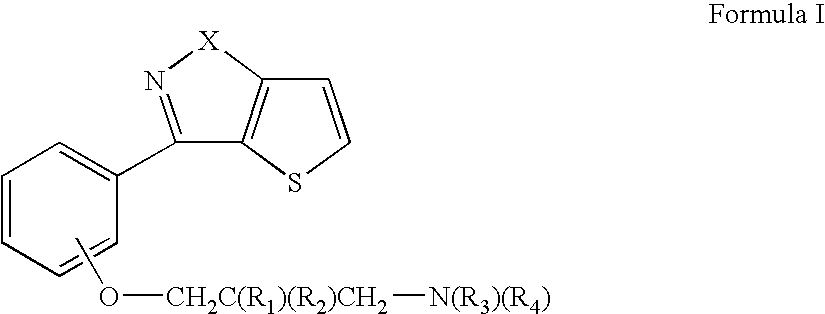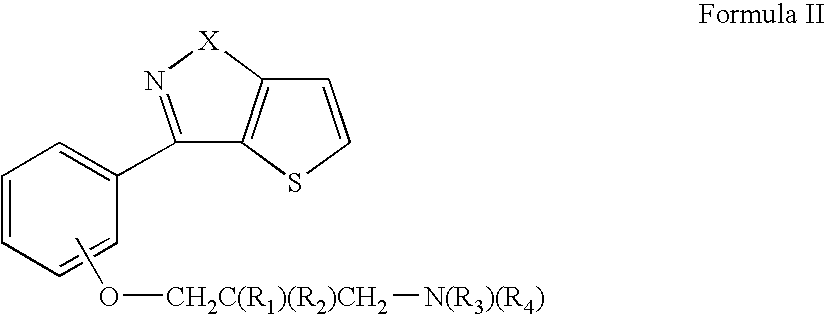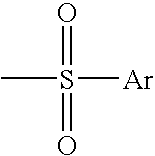Thienoisoxazolyl-and thienylpyrrazolyl phenoxy substituted propyl derivatives useful as d4 antagonists
a technology of thienylpyrrazolyl and thienylpyrrazolyl, which is applied in the field of thienoisoxazolyland thienylpyrrazolyl phenoxy substituted propyl derivatives useful as d4 antagonists, can solve the problems of inability to obtain specific data regarding gene frequency, and inability to meet the criteria
- Summary
- Abstract
- Description
- Claims
- Application Information
AI Technical Summary
Benefits of technology
Problems solved by technology
Method used
Image
Examples
example 1
Preparation of 3-thieno[2,3-d]isoxazol-3-yl-phenol (Scheme 1, Compound 9)
Step A:
Preparation of (3-bromothiophen-2-yl)-(3-methoxyphenyl)methanone (Scheme 1, Compound 5)
[0128]
[0129] Add phenyllithium (210 mL, 0.44 mol, 2.1 M in cyclohexane) dropwise, to a cold (5° C.) mixture of 3-bromothiophene (66 g, 0.40 mol) and ether (400 mL) over two hours to form the lithiated thiophene intermediate. Add the lithiated thiophene intermediate mixture to a cold (−70° C.) mixture of THF and m-methoxybenzoyl chloride over three hours, then quench the reaction with water and extract with ether. Wash the ether with 10% NaOH and water, dry (MgSO4), filter and evaporate to yield an oil. Purify the oil by column (alumina) chromatography, eluting with hexane up to 50% ether in hexane. Distill the product in vacuo and recrystallize (ether:hexane) to obtain the title compound (89.1 g, 75% Yield), m.p. 40° C.
Step B:
Preparation of (3-bromothiophen-2-yl)-(3-methoxyphenyl)methanone oxime (Scheme I, Compo...
example 2
Preparation of 3-(4-hydroxyphenyl)thieno[2,3-d]isoxazole
Step E:
Preparation of (3-bromo-thiophen-2-yl)-(4-methoxy-phenyl)-methanone (Scheme I, Compound 5)
[0136]
[0137] Treat a stirred, chilled (0° C.) solution of 3-bromothiophene (20 g, 0.123 mol) and dichloromethane (150 mL) with titanium tetrachloride in dichloromethane (184 mL, 1.0M) at such a rate as to maintain the temperature below 5° C. Add dropwise a solution of 4-methoxybenzoyl chloride (20.9 g, 0.123 mol) and dichloromethane (75 mL) at such a rate as to maintain the temperature below 5° C. Stir one hour at 0-5° C., then quench the reaction by addition of ice (100 mL) and 6N hydrochloric acid at such a rate that the internal temperature remains at or below 10° C. Add more water (100 mL), separate the organic phase, wash with water, dry (Na2SO4), filter and evaporate to an oil which solidifies. Recrystallize the solid from ether to afford the title compound as off-white crystals (19.7 g, 54%).
Step B
Preparation of (3-bro...
example 3
Preparation of 3-(1-methyl-1H-thieno[3,2-c]pyrazol-3-yl)phenol
Steps B and C
Preparation of 3-(3-methoxyphenyl)-1-methyl-1H-thieno[3,2-c]pyrazole: (Compound 8, Scheme I)
[0145]
[0146] Stir a mixture of (3-bromothiophen-2-yl)-(3-methoxyphenyl)methanone (20 g; 0.067 mol.; example 1, step A), ethylene glycol (134 mL) and methylhydrazine (17 g, 0.37 mol) under nitrogen at 120°-130° for 2.5 hours. Cool to room temperature, quench with water (200 mL) and extract with ether (4×200 mL). Dry the combined ether extracts (MgSO4), filter and evaporate the filtrate to an oil. Purify the oil by HPLC (3:1 hexane / ethyl acetate) to give a solid (9 g) and recrystallize from ether to give the title compound as crystals (8.2 g), m.p. 99°-101° C.
[0147] Analysis: Calculated for C13H12N2OS: 63.90% C, 4.95% H, 11.47% N. Found: 63.63% C, 5.03%, 11.52% N.
Step D
Preparation of 3-(1-methyl-1H-thieno[3,2-c]pyrazol-3-yl)phenol: (Compound 9, Scheme I)
[0148]
[0149] Treat a stirred solution of 3-(3-methoxyphenyl...
PUM
| Property | Measurement | Unit |
|---|---|---|
| time | aaaaa | aaaaa |
| temperature | aaaaa | aaaaa |
| temperature | aaaaa | aaaaa |
Abstract
Description
Claims
Application Information
 Login to View More
Login to View More - R&D
- Intellectual Property
- Life Sciences
- Materials
- Tech Scout
- Unparalleled Data Quality
- Higher Quality Content
- 60% Fewer Hallucinations
Browse by: Latest US Patents, China's latest patents, Technical Efficacy Thesaurus, Application Domain, Technology Topic, Popular Technical Reports.
© 2025 PatSnap. All rights reserved.Legal|Privacy policy|Modern Slavery Act Transparency Statement|Sitemap|About US| Contact US: help@patsnap.com



